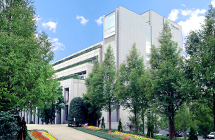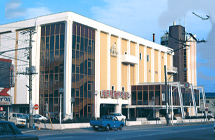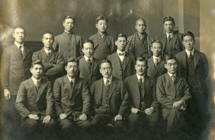
History 03
The Growth Period
From Post-War Ruin to a New Start and Rapid Growth through F1 Varieties
Sakata's Chigasaki Breedeing Station
The Chigasaki Breeding Station grew out of the ruins of war ; its core business was the breeding and cultivation of flowers.
The main focus was petunias for export. What stoked Takeo's passion the most was the red and white patterned, single-flowered petunia, the "Glitters" variety, which was announced in 1957. This new F1 variety, which followed in the footsteps of the prewar "Victorious" series, achieved very high standards and went on to win the bronze medal at the AAS, thus heralding the era of the single-flowered variety. The company made a name for itself internationally as "Sakata, of Petunia fame", achieving a rock-solid position in the horticultural industry.
In 1966, Sakata succeeded in the development of the "Majestic Giant" pansy with its large, 12 cm diameter flower. The "Majestic Giant Mix" and the "White with Blotch" varieties were both awarded bronze medals at the AAS.

Chigasaki Breeding Station(1945)

Farm of Kinpai

Majestic Giant Mix
In the 1960s, the Vegetable Division was in the initial stages of developing F1 varieties. Japan had entered a period of rapid economic growth and in order to meet the mass consumption needs for many agricultural products, improvements in quality and consistency were increasingly demanded. New F1 varieties that met these demands were praised as "ideal seeds". Sakata's new F1 cabbage "Kinpai" was awarded the Misister's Prize from the Ministry of Agriculture and Forestry in the National Vegetable Variety Contenst in 1957 and has since become one of Japan's motst loved varieties of spring cabbage.
Sensing the need to further develop vegetable varieties, in April 1960 Sakata bought four hectares of land in Fujisawa near Tokyo, and set up the Chogo Research Station. It was here that the Kinkei 201 and Kinshun varieties were developed, both of which are still highly esteemed to this day.
In April 1959, Sakata established the Misato Research Station in the highlands of Nagano Prefecture (at an altitude of around 700m) to test the feasibility of production in cooler, high altitude areas.
Ground-breaking F1 Melon "Prince" Creates a Sensation
In 1962, Sakata introduced the melon "Prince" revolutionizing the market for melons in Japan. From early on, musk melons were standard dessert items on the menus of expensive restaurants and were customarily given as presents to sick friends or relatives in hospital. The cultivation of musk melons required painstaking care in greenhouses.
The melon that was considered as having the most potential was developed in July 1961 and was very well received in taste tests in the market. This melon was named after the group of fruit merchants that oversaw the taste tests, which was known as the "Prince Committee". It was from 1961 that seed production began in earnest and the 1960s would be considered the melon "Prince era". Among Takeo's many fine accomplishments, the Prince melon, which was the product of a lot of trial and error, stands out as one of his greatest achievement.

Prince
Company Rationalization / Modernization and Organizational Restructuring
For his advanced flower breeding techniques and his significant success in promoting Japanese horticultural exports, Takeo received a blue ribbon Medal of Honor(awarded by the government of Japan to individuals who have made significant achievements) in 1958. Furthermore, he was the first foreigner to receive the AAS Medallion of Honor in August 1965.
Sakata felt the need to establish a national sales network and the Fukuoka Satellite Office on the southern island of Kyushu was opened in 1967. In October, Sakata opened the Fukushima extension and in June 1971, the Sendai Satellite Office in Northern Japan followed. These were used as bases to reinforce regional operations and sales.

Medallion of Honor

Fukuoka satellite office
Sakata Celebrates its 60th Anniversary and Further Breeding Research Expansion Planned
There was increasing momentum in the company to develop a new Research Station not only to increase the number of varieties in development but also to develop disease-resistant varieties and to conduct adaptability tests related to new breeding engineering technologies and vegetable cultivation methods, In June 1971, Sakata opened the Kimitsu Breeding Station in Chiba Prefecture near Tokyo, as a breeding center to play a central role in the development of vegetable varieties aimed at the domestic market. The Vegetable Production Department, which had been the main activity at the Chogo Research Station, was relocated to the Kimitsu Breeding Station. The Chigasaki Breeding Station, the Horticulture Department and a part of the Youg Plant Production Department moved to the Chogo Research Station, which then became the main research station for flowering plants.

Kimitsu Breeding Station

Green Duke
At around the same time, Sakata started to produce many F1 vegetable varieties that quickly became popular in the market, thus contributing to the company's domestic and international reputation.
The first product that became a hit was "Green Duke" broccoli, which was produced from 1969 at farm under consignment production agreements near the Xi Bei Farm in Taiwan and from which all seed was then exported to the US. Even though it was initially only the second most popular variety in the America, seed production techniques and stable mass production capabilities were established and supply operations commenced. As soon as word spread that the quality of our fruits and vegetables had improved (and yield had more than doubled), in no time the "Green Duke" conquered the market. This acted as a catalyst for the setting up of production centers in local regions. As a result of continuing efforts to develop new varieties and improve seed production techniques, Sakata's broccoli would, over the next 40 years, go on to take a 50% share of the world market.
The second hit was the revolutionary sweet corn "Honey Bantam". This variety, which had been available since 1974, went on to become extremely popular with urban consumers.

Honey Bantam

Honey Bantam labeled1

Honey Bantam labeled2
The third hit product was the F1 spinach variety "Atlas" which was released in 1972. This variety was the result of crossing female European spinach, which was resistant to downy mildew and damping-off diseases, with a typical male Japanese variety. Thus,"Atlas" was highly praised for both its disease resistance and high yield.
Sakata , which was leading the market with its continuous introduction into the market of new F1 vegetables, held a field day at the Misato Research Station in August 1973 in commemoration of its 60th anniversary.

Atlas













